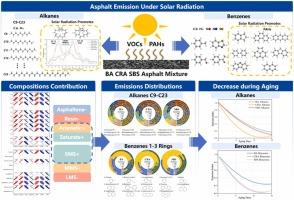沥青路面在太阳辐射作用下的辐射行为研究
IF 11.3
1区 环境科学与生态学
Q1 ENGINEERING, ENVIRONMENTAL
引用次数: 0
摘要
沥青路面排放的有毒烟雾,特别是挥发性有机化合物(VOCs)和多环芳烃(PAHs)的排放,仍然对公共安全造成健康和环境危害。尽管已经对施工阶段(即150 - 180°C)产生的沥青烟雾特征进行了广泛的研究,但在其使用寿命期间(即60 - 70°C)由太阳辐射引起的长期排放相对未被探索,特别是排放成分趋势及其与沥青成分的关系。本研究对三种常用沥青进行了不同加速老化时间的老化,并对其不同沥青成分在人工太阳辐射和70℃加热下的排放进行了分析比较。沥青在老化过程中普遍释放烷烃(C12 - C20)、单环苯系烃和多环芳烃,这些烷烃与芳烃和饱和组分的含量呈正相关。与70℃加热条件相比,人工太阳辐射促进了多环芳烃(即蒽、菲)、环烷烃(C14 - C25)和长链烷烃(C15 - C18)等污染物的额外释放。随着老化时间的延长,沥青在使用寿命期间的排放呈二次减少关系。结果揭示了太阳辐射下沥青的排放行为,揭示了沥青路面在使用寿命期间可能排放的污染物。本文章由计算机程序翻译,如有差异,请以英文原文为准。

Asphalt pavement emission behavior under solar radiation during in-service period
The toxic fume emitted from asphalt pavement remains a health and environmental hazard towards public safety, especially the emission of volatile organic compounds (VOCs) and polycyclic aromatic hydrocarbons (PAHs). Despite extensive studies focused on characterizing asphalt fumes generated during construction stages (i.e. 150–180°C) have already been conducted, the long-term emissions induced by solar radiation during its service life are relatively unexplored (i.e. 60–70°C), especially the emission composition trends and their relationship with asphalt composition. In this study, three commonly used asphalt were aged with different accelerated aging durations, and their emissions of different asphalt compositions under artificial solar radiation and 70°C heating were analyzed and compared. During the aging process, the asphalt generally emitted alkanes (C12 - C20), monocyclic benzene series and PAHs, which positively correlate with the contents of aromatic and saturate fractions. Compared to 70°C heating condition, the artificial solar radiation promoted the release of additional pollutants, including PAHs (i.e., anthracene, phenanthrene), cycloalkanes (C14 - C25) and long-chain alkanes (C15 - C18). Moreover, the asphalt emissions during service life exhibit a quadratic reduction relationship with longer aging durations. The results reveal the asphalt emission behavior under solar radiation, indicating potential emission pollutants during asphalt pavement service life.
求助全文
通过发布文献求助,成功后即可免费获取论文全文。
去求助
来源期刊

Journal of Hazardous Materials
工程技术-工程:环境
CiteScore
25.40
自引率
5.90%
发文量
3059
审稿时长
58 days
期刊介绍:
The Journal of Hazardous Materials serves as a global platform for promoting cutting-edge research in the field of Environmental Science and Engineering. Our publication features a wide range of articles, including full-length research papers, review articles, and perspectives, with the aim of enhancing our understanding of the dangers and risks associated with various materials concerning public health and the environment. It is important to note that the term "environmental contaminants" refers specifically to substances that pose hazardous effects through contamination, while excluding those that do not have such impacts on the environment or human health. Moreover, we emphasize the distinction between wastes and hazardous materials in order to provide further clarity on the scope of the journal. We have a keen interest in exploring specific compounds and microbial agents that have adverse effects on the environment.
 求助内容:
求助内容: 应助结果提醒方式:
应助结果提醒方式:


